Nov 11, 2011 | celebration, commemorative, museum
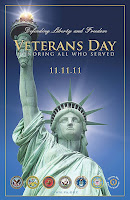 On the “eleventh hour of the eleventh day of the eleventh month” in 1918, hostilities were ended on the Western Front of World War I. Although this is accepted as the end of the “War to End All Wars,” fighting continued across the Russian Empire and in areas of the old Ottoman Empire. A year later, President Woodrow Wilson proclaimed November 11 Armistice Day as a national holiday to celebrate those who served and honor those that died.
On the “eleventh hour of the eleventh day of the eleventh month” in 1918, hostilities were ended on the Western Front of World War I. Although this is accepted as the end of the “War to End All Wars,” fighting continued across the Russian Empire and in areas of the old Ottoman Empire. A year later, President Woodrow Wilson proclaimed November 11 Armistice Day as a national holiday to celebrate those who served and honor those that died.
Alvin King, a shoe repair shop owner in Emporia, Kansas, had the idea to celebrate all veterans on November 11. King lobbied the city of Emporia to close in honor of all veterans. Representative Ed Rees of Emporia shepherded a bill through congress to rename the holiday Veterans Day to honor all who have served. President Dwight Eisenhower signed the bill into law in 1954.
On Veterans Day, we pay tribute to our veterans, to the fallen, and to their families. To honor their contributions to our Nation, let us strive with renewed determination to keep the promises we have made to all who have answered our country’s call. As we fulfill our obligations to them, we keep faith with the patriots who have risked their lives to preserve our Union, and with the ideals of service and sacrifice upon which our Republic was founded.†
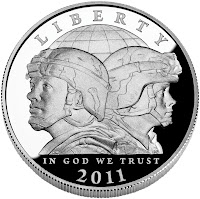 If you are looking for a way to honor veterans, consider supporting The Army Historical Foundation and their effort to build The National Museum of the United States Army. You can support their efforts by donating to the organization or by purchasing a 2011 United States Army Commemorative Coin. Available as a $5 gold coin, $1 silver coin, and half-dollar clad coin, the surcharges ($35 gold, $10 silver, and $5 clad) will be paid to The Army Historical Foundation to support the construction of the museum.
If you are looking for a way to honor veterans, consider supporting The Army Historical Foundation and their effort to build The National Museum of the United States Army. You can support their efforts by donating to the organization or by purchasing a 2011 United States Army Commemorative Coin. Available as a $5 gold coin, $1 silver coin, and half-dollar clad coin, the surcharges ($35 gold, $10 silver, and $5 clad) will be paid to The Army Historical Foundation to support the construction of the museum.
Take this opportunity to honor the nation’s veterans and support this worthy effort.
To all that have served…
To all that have given the ultimate sacrifice…
To the families of these honored service members…
THANK YOU!
† From the Veterans Day, 2011 Presidential Proclamation signed by President Barack Obama.
Veterans Day 2011 poster courtesy of the Department of Veterans Affairs.
Coin image courtesy of the U.S. Mint.
Sep 11, 2011 | commemorative, history
 For those of us who lived through these events, the only marker we’ll ever need is the tick of a clock at the 46th minute of the eighth hour of the 11th day.
For those of us who lived through these events, the only marker we’ll ever need is the tick of a clock at the 46th minute of the eighth hour of the 11th day.
—President George W. Bush
Thousands of lives were suddenly ended by evil, despicable acts of terror. The pictures of airplanes flying into buildings, fires burning, huge structures collapsing, have filled us with disbelief, terrible sadness and a quiet, unyielding anger.
—President George W. Bush
Our enemies have made the mistake that America’s enemies always make. They saw liberty and thought they saw weakness. And now, they see defeat.
—President George W. Bush
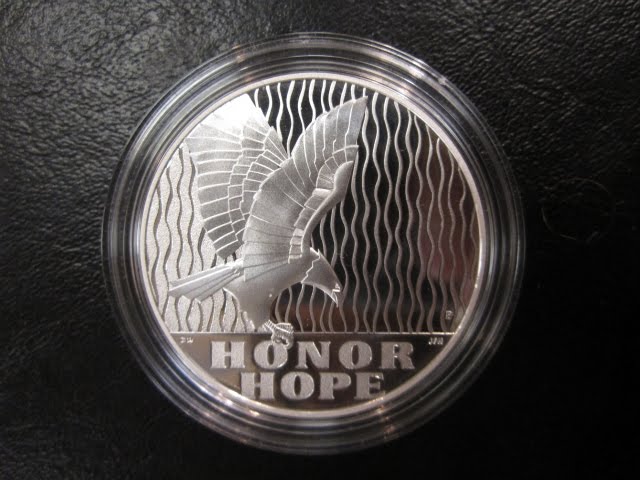
The attacks of September 11th were intended to break our spirit. Instead we have emerged stronger and more unified. We feel renewed devotion to the principles of political, economic and religious freedom, the rule of law and respect for human life. We are more determined than ever to live our lives in freedom.
—Mayor Rudolph W. Giuliani,
December 31, 2001
Now, we have inscribed a new memory alongside those others. It’s a memory of tragedy and shock, of loss and mourning. But not only of loss and mourning. It’s also a memory of bravery and self-sacrifice, and the love that lays down its life for a friend–even a friend whose name it never knew.”
—President George W. Bush, December 11, 2001
This is a day when all Americans from every walk of life unite in our resolve for justice and peace. America has stood down enemies before, and we will do so this time. None of us will ever forget this day. Yet, we go forward to defend freedom and all that is good and just in our world. Thank you. Good night, and God bless America.
—President George W. Bush, September 11, 2001
$10 from the sale of every 9/11 Commemorative Medal goes to the National September 11 Memorial & Museum.
Aug 15, 2011 | coins, commemorative, legislative
Every week I check the progress of coin bills in winding its way through congress. As there are new bills or updates, I make sure the Coin Bills in the 112th Congress page is updated. Having not done so since congress went on their summer vacation, I decided to see if there was anyto change prior to their leaving Washington.
As opposed to previous congresses, the 112th congress has been pretty dull when it comes to coin legislation. Not only have fewer bills been introduced, but the bills that have been introduced have been sitting in committee going nowhere. That is until now.
According to the record, the National Baseball Hall of Fame Commemorative Coin Act (H.R. 2527) was voted out of the House Financial Services Committee by voice vote on July 20 and ordered to be reported to the House Floor for consideration. Although the bill was also referred to the House Budget Committee, House rules allow Speaker of the House John Boehner to schedule it for debate and vote on the House floor without consent of the Budget Committee.
Of all the coin-related bills introduced in the 112th congress, this is the only one that has had any action following introduction.
Other than directing the U.S. Mint to strike $5 gold coins, silver dollars, and clad half-dollars in recognition of the National Baseball Hall of Fame during 2015, H.R. 2527 requires the coin to be concave/convex to depict a baseball on the reverse and have a competition for the obverse. Read my prior post, “A Commem to Take Out to the Ball Game” for more on this bill.
Given the toxic nature of how both sides of the aisle has done business, it is good to see at least one committee can come together for at least one bill!
Jul 17, 2011 | coins, commemorative, legislative, US Mint
 In a very rare show of bipartisan ship in the House of Representatives, Rep. Richard Hanna (R-NY24) introduced H.R. 2527, National Baseball Hall of Fame Commemorative Coin Act. Hanna, whose district includes Cooperstown, submitted the bill with 293 sponsors, including the entire New York delegation from both parties. This might be the first coin-related legislation to see action in the 112th congress.
In a very rare show of bipartisan ship in the House of Representatives, Rep. Richard Hanna (R-NY24) introduced H.R. 2527, National Baseball Hall of Fame Commemorative Coin Act. Hanna, whose district includes Cooperstown, submitted the bill with 293 sponsors, including the entire New York delegation from both parties. This might be the first coin-related legislation to see action in the 112th congress.
The National Baseball Hall of Fame and Museum opened in Cooperstown, New York on June 12, 1939. Its first inductees class include five payers who many consider amongst the greatest who have ever played professional baseball. These inductees were (in alphabetical order):
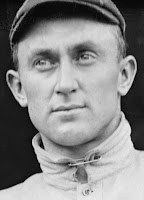 Tyrus Raymond “Ty” Cobb, also known as “The Georgia Peach,” set 90 Major League Baseball Records including highest career batting average (.367) and most career batting titles (12) which he still holds today. His 24-year career was also memorable for his surly temperament and aggressive playing style. When he was voted in to National Baseball Hall of Fame on its inaugural ballot in 1936, he received 222 out of a possible 226 votes, the most of this entry class. The other four votes were probably from sportswriters Cobb made upset during the course of his career.
Tyrus Raymond “Ty” Cobb, also known as “The Georgia Peach,” set 90 Major League Baseball Records including highest career batting average (.367) and most career batting titles (12) which he still holds today. His 24-year career was also memorable for his surly temperament and aggressive playing style. When he was voted in to National Baseball Hall of Fame on its inaugural ballot in 1936, he received 222 out of a possible 226 votes, the most of this entry class. The other four votes were probably from sportswriters Cobb made upset during the course of his career. Walter “Big Train” Johnson played 21 years for the original Washington Senators, 1907-1927. Johnson is second in all time wins with 417 (Cy Young won 511) and is still the all-time career leader in shutouts with 110. Using scientific tests available at the time, Johnson’s fastball was clocked at over 91 miles per hour which was phenomenal for the time. His motion and fastball fooled many hitters, especially right handers. Many of his strikeout records lasted more than 50 years before being broken by future Hall of Famers Bob Gibson, Nolan Ryan, Steve Carlton, and Gaylord Perry.
Walter “Big Train” Johnson played 21 years for the original Washington Senators, 1907-1927. Johnson is second in all time wins with 417 (Cy Young won 511) and is still the all-time career leader in shutouts with 110. Using scientific tests available at the time, Johnson’s fastball was clocked at over 91 miles per hour which was phenomenal for the time. His motion and fastball fooled many hitters, especially right handers. Many of his strikeout records lasted more than 50 years before being broken by future Hall of Famers Bob Gibson, Nolan Ryan, Steve Carlton, and Gaylord Perry. Christy Mathewson holds the National League record for wins with 373. In 17 years, he won all but one of those games with the New York Giants. In 1916, Mathewson was traded to the Cincinnati Reds and became their manager. During his career, Mathewson was famous for his duels with Mordecai “Three Finger” Brown, mostly against the Chicago Cubs. Brown got the best of Mathewson 13-11 with one no-decision. Johnson’s career was cut short when he was accidentally gassed during World War I.
Christy Mathewson holds the National League record for wins with 373. In 17 years, he won all but one of those games with the New York Giants. In 1916, Mathewson was traded to the Cincinnati Reds and became their manager. During his career, Mathewson was famous for his duels with Mordecai “Three Finger” Brown, mostly against the Chicago Cubs. Brown got the best of Mathewson 13-11 with one no-decision. Johnson’s career was cut short when he was accidentally gassed during World War I.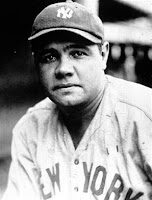 George Herman “Babe” Ruth, “the Bambino,” “the Sultan of Swat,” the former pitcher turned outfielder is largely credited for saving baseball after the Chicago Black Sox Scandal during the 1919 World Series. Baseball needed a new hero and Babe Ruth was there with a mighty bat. The sale of his contract from the Red Sox to the Yankees in December 1919 had been part of Red Sox lore and hung like an albatross until the BoSox won the World Series in 2004—which they beat the Yankees to get into the World Series after being down three games to one in the ALCS!
Babe Ruth was baseball’s first home run king. In 1921, Ruth hit 59 home runs while the Yankees shared the Polo Grounds with the Giants. That record stood until Ruth belted 60 for the “Murderer’s Row” team of 1927. It was a record that stood until Roger Maris hit 61 in 1961. His 714 career home runs served as a record until broken by Hank Aaron in 1974. Ruth’s .690 slugging percentage remains a record.
George Herman “Babe” Ruth, “the Bambino,” “the Sultan of Swat,” the former pitcher turned outfielder is largely credited for saving baseball after the Chicago Black Sox Scandal during the 1919 World Series. Baseball needed a new hero and Babe Ruth was there with a mighty bat. The sale of his contract from the Red Sox to the Yankees in December 1919 had been part of Red Sox lore and hung like an albatross until the BoSox won the World Series in 2004—which they beat the Yankees to get into the World Series after being down three games to one in the ALCS!
Babe Ruth was baseball’s first home run king. In 1921, Ruth hit 59 home runs while the Yankees shared the Polo Grounds with the Giants. That record stood until Ruth belted 60 for the “Murderer’s Row” team of 1927. It was a record that stood until Roger Maris hit 61 in 1961. His 714 career home runs served as a record until broken by Hank Aaron in 1974. Ruth’s .690 slugging percentage remains a record.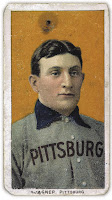 Johannes Peter “Honus” Wagner was probably baseball’s first superstar. Playing most of his career with the Pittsburgh Pirates, Wagner won eight batting titles which is tied for the most in the National League with Tony Gwynn. One of the highlights of Wagner’s career was when the Pirates faced the Detroit Tigers in the 1909 World Series. The Tigers were lead by the 22-year old Ty Cobb. Vowing not to have the same poor showing as he did during the 1903 World Series, Wagner out hit Cobb .333 to .231 and stole six bases, setting a World Series record. At 35 years old, Wagner lead his Pirates to victory over the Tigers, 4-3. Wanger’s T206 Baseball card made by the American Tobacco Company is the most expensive baseball card in the world—only 57 are known to exist.
Johannes Peter “Honus” Wagner was probably baseball’s first superstar. Playing most of his career with the Pittsburgh Pirates, Wagner won eight batting titles which is tied for the most in the National League with Tony Gwynn. One of the highlights of Wagner’s career was when the Pirates faced the Detroit Tigers in the 1909 World Series. The Tigers were lead by the 22-year old Ty Cobb. Vowing not to have the same poor showing as he did during the 1903 World Series, Wagner out hit Cobb .333 to .231 and stole six bases, setting a World Series record. At 35 years old, Wagner lead his Pirates to victory over the Tigers, 4-3. Wanger’s T206 Baseball card made by the American Tobacco Company is the most expensive baseball card in the world—only 57 are known to exist.
There have been 205 former major leaguers, 27 executives, 35 Negro League players, 19 managers, and 9 umpires elected to the Hall of Fame. There are currently 63 living members. Exhibits include Women in Baseball, ¡Viva Baseball! celebrating baseball in Latin America and the Caribbean, and The Records Room that shows off the real equipment used to set Major League records.
Should the bill pass, it calls for the minting of 750,000 half-dollar clad coins, 400,000 $1 silver coins, and 50,000 $5 dollar gold coins in 2015. The sale of these coins will include a $35 surcharge for the gold coin, $10 for the silver dollar, and $5 for the clad half-dollar. The potential income of $9.5 million will be paid to the National Baseball Hall of Fame to help finance its operations.
According to the bill, the obverse design of the coin will require an open competition. “The competition shall be judged by an expert jury chaired by the Secretary and consisting of 3 members from the Citizens Coinage Advisory Committee who shall be elected by such Committee and 3 members from the Commission of Fine Arts who shall be elected by such Commission.” The bill said that the “Secretary shall determine compensation for the winning design, which shall be not less than $5,000.” Of course there is a catch. The bill says that the “Secretary may not accept a design for the competition unless a plaster model accompanies the design.”
For the reverse, the bill says the coins “shall depict a baseball similar to those used by Major League Baseball.”
But there is an interesting catch to the design specified in the bill. The bill wants the coin design “fashion[ed] similar to the 2009 International Year of Astronomy coins issued by Monnaie de Paris, the French (sic) Mint, so that the reverse of the coin is convex to more closely resemble a baseball and the obverse concave, providing a more dramatic display of the obverse design chosen.” This should give the U.S. Mint some use for the machinery they used to strike the 2009 Ultra High Relief Double Eagle Gold Coin.
With 293 co-sponsors from both sides of the aisle, there should be no reason for this this bill not to pass—but stranger things have happened with this congress already. The bill has been referred to the House Financial Services Committee where it will likely to be assigned to the Subcommittee on Domestic Monetary Policy and Technology chaired by Rep. Ron Paul (R-TX). In the “what could go wrong” category, Rep. Paul is not considered a friend to the U.S. Mint or its practices.
The bill has also been referred to the House Budget Committee who has its hands full with other matters. Budget Committee Chairman Rep. Paul Ryan (R-WI) is also known not to be a fan of the government.
Neither Paul or Ryan are co-sponsors of this bill. Maybe they can put aside their partisan differences like others who have co-sponsored the bill since baseball is something we can all agree on. As a long time baseball fan, I would buy these commemoratives. I hope congress gives me the chance!
Baseball Hall of Fame image courtesy of the National Baseball Hall of Fame and Museum.
All other pictures courtesy of Wikimedia.
Jul 11, 2011 | coins, commemorative, foreign
Long before the invention of electricity, before steam powered everything, and even before the perfection in the forging of iron and steel to make manual machines, coins were hammered by strong men in order to impress the image on the coinage metals.
Hammered coins were struck from ancient times until the screw coin press was invented by German silversmith Max Schwab around 1550. Hammered coins were struck by frost placing a coin blank on a stationary die (anvil die) that was attached or sunk into a log or another hard surface. The anvil die produced the reverse image. Then, holding the obverse die (trussel) in one hand, the coiner swung the hammer and forced the dies into the coin blank. The pressure from the hammering pushed the metal into the crevices of the dies including the stationary lower die to create the impression. It would take multiple hammer strikes in order to impress the image into the coin.
Hammered coins were rarely perfectly round. Aside from there being no collar surrounding the blank to keep it in place, Depending on the strength and skill of the coiner, the image may not transfer perfectly, the thickness may vary, the coin could exhibit flat edges, and striking errors. Collectors of these coins, mostly pre-17th century, find beauty in the character of each strike.
Monnaie de Paris (The Paris Mint) announced that it will create coins with the theme “From Clovis to the Republic” commemorating 1500 years of the history of France. The theme and design concepts were created by famed designer Christian Lacroix, Artistic Advisor of the Monnaie de Paris. The series will celebrate 15 kings, emperors, and presidents over five years that represents French history from Clovis I through Fraçois Metterand.
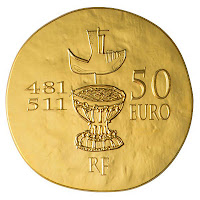
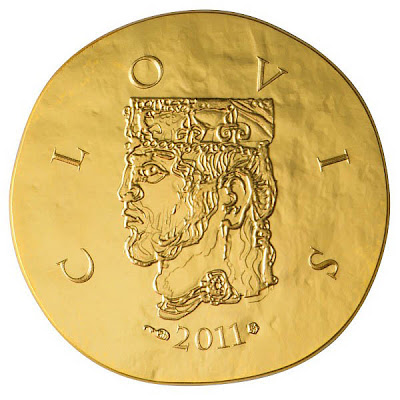 The first coin commemorate Clovis I. Clovis was the first King of the Franks. Clovis was the first Catholic king who united all of the Frankish tribes under one ruler. The second coin in the series features Charlemagne, the first Holy Roman Emperor and King of the Franks who created the first European-based empire. Both France and Germany traces their history back to Charlemagne.
The first coin commemorate Clovis I. Clovis was the first King of the Franks. Clovis was the first Catholic king who united all of the Frankish tribes under one ruler. The second coin in the series features Charlemagne, the first Holy Roman Emperor and King of the Franks who created the first European-based empire. Both France and Germany traces their history back to Charlemagne.
To give the coin a similar character to what might have existed during the time of Clovis and Charlemagne, Monnaie de Paris developed a method to make the coin appear to be hammer struck using modern minting equipment. The obverse of both coins has a portrait as it might have appeared at the time.
The reverse of the Clovis coin has a dove flying over a baptismal font representing his Catholic heritage.
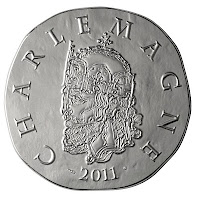
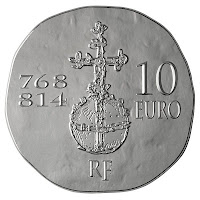 The reverse of the Charlemagne coin features a cross-bearing orb (globus cruciger in Latin), Charlemagne’s symbol of his sovereignty and power as the first emperor of the Holy Roman Empire.
The reverse of the Charlemagne coin features a cross-bearing orb (globus cruciger in Latin), Charlemagne’s symbol of his sovereignty and power as the first emperor of the Holy Roman Empire.
To the left of the reverse image are the years of their reign. To the right is the denomination. Below the image are the letters “RF” for République Français for “The French Republic.”
For each commemorative. Monnaie de Paris will be producing two coins. The 10 Euro coin is made from 22.2 grams of .900 fine silver and has a production limit of 20,000 coins at a cost of 65 € (54.35 € without VAT for outside of Europe). The 50 Euro coin is made from 8.45 grams (quarter-ounce) of .920 fine gold (22-Karat) and has a production limit of 1,500 coins and will cost 427 €. Those of us who live outside of Europe can find regional authorized distributors using a web search.
I like the idea to make commemoratives honoring historic figures designed and struck to look close to period pieces. It will be interesting to see how the people who vote for Coin of the Year reacts to these coins.
Coin images courtesy of Monnaie de Paris.
Jun 24, 2011 | commemorative, US Mint
This past Tuesday, Treasurer of the United States Rosie Rios, U.S. Representative Jerrold Nadler (D-NY), and Joe Daniels, president and CEO of the National September 11 Memorial & Museum, announced the opening of sales for the 2011 September 11 National Medal at the 9/11 Memorial Preview Site. As part of the ceremony, Rios and Nadler presented a shadowbox containing the medal to Daniels.
Numismatic News’s Dave Harper reports that the U.S. Mint has sold 35,036 medals (21,256 “W” mintmarked and 13,780 “P” mintmarked). The authorizing law (Public Law No. 111-221 [Text] [PDF]) authorizes the production of 2 million one-ounce proof silver medals with a surcharge of $10 per medal will be paid to the National September 11 Memorial & Museum.
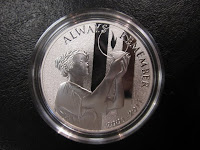
 Although the images provided by the U.S. Mint are representative of the medal, there are many cases that the coin or medal looks better than the U.S. Mint’s image. While searching for a information about the launch ceremony, I came upon a story at DNAinfo.com, a website that covers news and events in Manhattan. The reporter, Julie Shaprio, was able to photograph an actual medal at the site. I was awed by the images of the actual medal. Once again, the photographs prove that the actual medal is much better looking than the U.S. Mint’s image.
Although the images provided by the U.S. Mint are representative of the medal, there are many cases that the coin or medal looks better than the U.S. Mint’s image. While searching for a information about the launch ceremony, I came upon a story at DNAinfo.com, a website that covers news and events in Manhattan. The reporter, Julie Shaprio, was able to photograph an actual medal at the site. I was awed by the images of the actual medal. Once again, the photographs prove that the actual medal is much better looking than the U.S. Mint’s image.
The medal was designed by Donna Weaver, a former U.S. Mint sculptor-engraver now a member of the Artistic Infusion Program. The obverse was engraved by Phebe Hemphill and the reverse by Joseph Menna. All should be commended on an excellent job.
Image of the 9/11 Medal courtesy of Julie Shapiro of DNAinfo.com.
Click on the images to see larger versions.
May 30, 2011 | commemorative, history
The first recorded organized public recognition of the war dead occurred on May 1, 1865 in Charleston, South Carolina. On that day, Freedmen (freed southern slaves) celebrated the service of the 257 Union soldiers buried at the Washington Race Course (now Hampton Park). They labeled the gravesite “Martyrs of the Race Course.” African Americans continued that tradition and named the celebration Decoration Day.
 The next year, southern states began their own Memorial Days to honor their soldiers who died during the war. No specific date was used but occurred in late April through June. By 1880, there was a more organized Confederate Memorial Day. These celebrations honored specific soldiers to commemorate the Confederate “Lost Cause.” By 1913, a sense of nationalism saw a commemoration of all soldiers that have died in battle.
The next year, southern states began their own Memorial Days to honor their soldiers who died during the war. No specific date was used but occurred in late April through June. By 1880, there was a more organized Confederate Memorial Day. These celebrations honored specific soldiers to commemorate the Confederate “Lost Cause.” By 1913, a sense of nationalism saw a commemoration of all soldiers that have died in battle.
In the north, the fraternal organization of Civil War veterans The Grand Army of the Republic began organizing “Decoration Day” in 1868. Decoration Day was to honor the fallen by decorating the graves of Union soldiers with flowers and flags. Ceremonies included speeches that were a mix of religion, nationalism, and a rehash of history in vitriolic terms against the Southern soldiers. The acrimony against the South began to subside by the end of the 1870s
Although Ironton, Ohio and Columbus, Mississippi claims to have the oldest and longest running celebrations, the most famous was started at Gettysburg National Park in 1868.
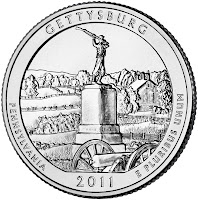 Gettysburg is the location of the three day battle where Union Major General George Gordon Meade’s Army of the Potomac defeated attacks by Confederate Gen. Robert E. Lee’s Army of Northern Virginia. It was the bloodiest battle of the Civil War and had the largest number of casualties. During a 50th Anniversary memoriam of the deceased, veteran of the Union and Confederate armies gathered for a four-day “Blue-Gray Reunion.” The event included speeches by President Woodrow Wilson, the first southern elected president since the Civil War, and Congressman James T. Heflin of Alabama. Heflin’s speech was memorable in his endorsement of building the Lincoln Memorial and a call for a Mother’s Day holiday.
Gettysburg is the location of the three day battle where Union Major General George Gordon Meade’s Army of the Potomac defeated attacks by Confederate Gen. Robert E. Lee’s Army of Northern Virginia. It was the bloodiest battle of the Civil War and had the largest number of casualties. During a 50th Anniversary memoriam of the deceased, veteran of the Union and Confederate armies gathered for a four-day “Blue-Gray Reunion.” The event included speeches by President Woodrow Wilson, the first southern elected president since the Civil War, and Congressman James T. Heflin of Alabama. Heflin’s speech was memorable in his endorsement of building the Lincoln Memorial and a call for a Mother’s Day holiday.
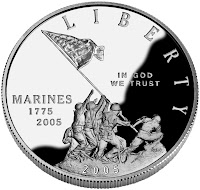 Memorial Day did not take on national significances until after World War I. Rather than being a holiday to remember those of died in service during the Civil War, the nation began to recognize all those who gave the ultimate sacrifice during all conflicts. By the end of World War II, most of the celebrations were renamed from Decoration Day to Memorial Day. Memorial Day did not become an official holiday until 1967 and its date changed from the traditional May 30 to the last Monday of the month by the Uniform Holidays Act (Public Law 90-363, 5 U.S.C. § 6103(a)) in 1968.
Memorial Day did not take on national significances until after World War I. Rather than being a holiday to remember those of died in service during the Civil War, the nation began to recognize all those who gave the ultimate sacrifice during all conflicts. By the end of World War II, most of the celebrations were renamed from Decoration Day to Memorial Day. Memorial Day did not become an official holiday until 1967 and its date changed from the traditional May 30 to the last Monday of the month by the Uniform Holidays Act (Public Law 90-363, 5 U.S.C. § 6103(a)) in 1968.
The modern Memorial Day is a holiday celebrating the lives of those sacrificed in defense of the United States and its ideals at home and abroad. Today, we honor the memories of those who paid the ultimate sacrifice so that I can write this blog and you can read it.
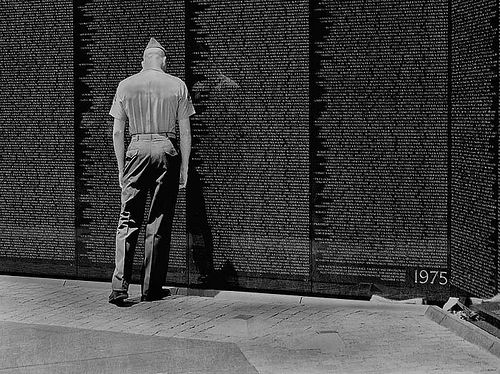
Coin images courtesy of the U.S. Mint.
Vietnam Memorial image from Wikimedia.
May 2, 2011 | commemorative, medals, news
We learned from President Barack Obama that the Joint Special Operations Command found Osama Bin Laden in a compound outside of Islamabad, Pakistan and killed him during a raid. A grateful nation thanks the members of JSOC for your successful operation and we are glad that none of your members were injured in the process.
 With the death of Osama Bin Laden nearly ten years after the attacks on September 11, 2001, we should remember all of those that died in those attacks on U.S. soil at the World Trade Center, the Pentagon, and Shanksville, Pennsylvania. We should also honor the sacrifices made by the members of the United States military and their families who gave of themselves and lives in the war on terrorism.
With the death of Osama Bin Laden nearly ten years after the attacks on September 11, 2001, we should remember all of those that died in those attacks on U.S. soil at the World Trade Center, the Pentagon, and Shanksville, Pennsylvania. We should also honor the sacrifices made by the members of the United States military and their families who gave of themselves and lives in the war on terrorism.
As numismatists, we can show our support in many ways. One way is to remember that later this year, the U.S. Mint will issue a silver commemorative medal whose surcharge of $10 per medal will be paid to the National September 11 Memorial & Museum at the World Trade Center to support the operations and maintenance. The bill, National September 11 Memorial & Museum Commemorative Medal Act of 2010, was signed into law on August 6, 2010 (Public Law No. 111-221 [Text] [PDF]) authorizes the production of 2 million one-ounce proof silver medals.
 According to the law, the “design of the medals struck under this Act shall be emblematic of the courage, sacrifice, and strength of those individuals who perished in the terrorist attacks of September 11, 2001, the bravery of those who risked their lives to save others that day, and the endurance, resilience, and hope of those who survived.” Each medal must include the inscription of the years “2001-2011” and “Always Remember.” Medals can only be struck at the U.S. Mint facility at West Point and at Philadelphia.
According to the law, the “design of the medals struck under this Act shall be emblematic of the courage, sacrifice, and strength of those individuals who perished in the terrorist attacks of September 11, 2001, the bravery of those who risked their lives to save others that day, and the endurance, resilience, and hope of those who survived.” Each medal must include the inscription of the years “2001-2011” and “Always Remember.” Medals can only be struck at the U.S. Mint facility at West Point and at Philadelphia.
At last report, the images in this post are those that have been recommended by the U.S. Commission of Fine Arts and the Citizens Coinage Advisory Committee. The U.S. Mint has not announced the whether they accepted the recommendations or when the medals will be available for purchase. Although I am not a medal collector, this is one medal I will purchase!
As for my feelings, I think the great jurist Clarence Darrow summed it up best: “I never wanted to see anybody die, but there are a few obituary notices I have read with pleasure.”
Mar 15, 2011 | ancient, coins, commemorative
 One of the most recognizable coin from ancient Rome is the Eid Mar denarius commemorative coin issued by Marcus Junius Brutus after he participated in the assassination of Julius Cæsar on the Ides of March (15th of March), 44 B.C.E. The fame of this coin was already cemented by the time Roman historian Cassius Dio wrote sometime in the second century, “Brutus stamped upon the coins which were being minted in his own likeness and a cap and two daggers, indicating by this and by the inscription that he and Cassius had liberated the fatherland.”
One of the most recognizable coin from ancient Rome is the Eid Mar denarius commemorative coin issued by Marcus Junius Brutus after he participated in the assassination of Julius Cæsar on the Ides of March (15th of March), 44 B.C.E. The fame of this coin was already cemented by the time Roman historian Cassius Dio wrote sometime in the second century, “Brutus stamped upon the coins which were being minted in his own likeness and a cap and two daggers, indicating by this and by the inscription that he and Cassius had liberated the fatherland.”
On the Ides of March, a group of senators conspired to assassinate Julius Cæsar to liberate the Roman Republic and save it from Cæsar’s tyranny. Brutus, who Cæsar thought was a friend and ally, was a leader of the conspirators. After Cæsar arrived at the senate, the conspirators stabbed Cæsar 23 times using daggers they hid under their robes. Cæsar died after seeing that Brutus was part of the conspiracy. William Shakespeare dramatizes this scene in Act 3, Scene 1 of the play Julius Cæsar:
Cæsar: Doth not Brutus bootless kneel?
Casca: Speak, hands, for me! [The conspirators stab Cæsar]
Cæsar: [Turning to Brutus] Et tu, Brute? Then fall, Cæsar!
[Cæsar dies]
Cinna: Liberty! Freedom! Tyranny is dead!
Run hence, proclaim, cry it about the streets.
Cassius: Some to the common pulpits, and cry out
‘Liberty, freedom, and enfranchisement!’
Brutus: People and senators, be not affrighted;
Fly not; stand stiff: ambition’s debt is paid.
 There are 60 known examples of the EID MAR denarius in silver and only one known gold example. The gold coin is on loan to the British Museum. The obverse of the coin features the bust of Brutus with the inscription “BRVT IMP L PLAET CEST” which means “Brutus, Imperator (honored military commander), Lucius Plætorius Cestianus.” Lucius Plætorius Cestianus was the manager of the mint workers. It was common for the coiner’s name to appear on Roman coinage as a guarantee to the quality of the metal. The reverse features two daggers on either side of a liberty cap, a symbol of freedom. Inscribed below the cap is “EID MAR,” for the Latin Eidibus Martiis or the “Ides of March” to commemorate the day he saved the republic.
There are 60 known examples of the EID MAR denarius in silver and only one known gold example. The gold coin is on loan to the British Museum. The obverse of the coin features the bust of Brutus with the inscription “BRVT IMP L PLAET CEST” which means “Brutus, Imperator (honored military commander), Lucius Plætorius Cestianus.” Lucius Plætorius Cestianus was the manager of the mint workers. It was common for the coiner’s name to appear on Roman coinage as a guarantee to the quality of the metal. The reverse features two daggers on either side of a liberty cap, a symbol of freedom. Inscribed below the cap is “EID MAR,” for the Latin Eidibus Martiis or the “Ides of March” to commemorate the day he saved the republic.
Anyone in the area of the British Museum on the Ides of March, they are presenting a gallery talk by Ian Leins of the British Museum about the Ides of March. The free 45-minute gallery talk will begin at 13.15 (1:15 P.M. London Time) in Room 68. This would be a fantastic… visit one of the world’s greatest museums and take a break with an interesting talk!
Image of the Eid Mar silver coin courtesy of dig4coins.com.
Image of the Eid Mar gold coin courtesy of the British Museum via guardian.co.uk.
Nov 6, 2010 | commemorative, legislative, palladium, policy
Recently, I met someone familiar with the internal workings of congress. After talking about the election, I asked about the coin-related bills that were still in congress waiting for action in the lame duck session. I passed along the link to my post about Coin Legislation in the 111th Congress and asked if any of the bills passed the House of Representatives and in a Senate committee had the chance of being voted on. I was given the following report:
Bills Passed by the House and Referred to the Senate
Three bills have passed the House and sent to the Senate for their action. These bills are currently waiting for action in the Committee on Banking, Housing, and Urban Affairs. All three bills are expected to pass with the following modifications:
- Mother’s Day Centennial Commemorative Coin Act will pass without modification.
- American Eagle Palladium Bullion Coin Act of 2010 will be modified to allow the U.S. Mint to begin striking palladium coins in 2012.
- Coin Modernization, Oversight, and Continuity Act of 2010 will pass with the possible modification that the report is due to congress within 15 days of the end of the 2012 fiscal year.
Bills that are modified are required to be reconciled by a conference committee or just accepted by the House. It is expected that the House will accept the modifications by unanimous consent and will be signed by the president.
Bills Introduced in the House of Representatives
There are 13 commemorative coin bills waiting for action in the House Subcommittee on Domestic Monetary Policy and Technology. None of the bills are expected to receive attention and will “die in committee” at the adjournment of the 111th Congress.
In addition to the commemorative bills, there are three other bills related to collectors and investors that are likely to see some action:
- Free Competition in Currency Act of 2009 was introduced by Ron Paul (R-TX) and referred to the Subcommittee on Commercial and Administrative Law. The basic provisions of this bill calls for the elimination of all taxes on the sale and transfer of bullion and coins. It also changes the law to allow precious metals to be used as coins or a medium of exchange. As the future chairman of the Domestic Monetary Policy and Technology Subcommittee, Paul may not push this bill. Rather, he will wait until the 112th congress to have it assigned to his subcommittee so he can control the outcome. This bill is unlikely to pass in the Democratic-controlled lame duck congress.
- Coin and Precious Metal Disclosure Act was introduced by Anthony D. Weiner (D-NY) and referred to the House Committee on Energy and Commerce. This bill is referred to as the Goldline Act since Rep. Weiner has targeted Goldline in his commentary regarding this bill. Because of the controversial nature of this bill and the potential for side effects that could hurt other industries, it is unlikely that this bill will be brought up again in committee.
- Small Business Paperwork Mandate Elimination Act was introduced by Dan Lungren (R-CA) and referred to the House Committee on Ways and Means. This is the bill that will remove the requirement to report all goods and services purchased in excess of $600 with an IRS 1099 form beginning in 2012 that was part of the health care reform legislation. Almost everyone in almost every industry is in favor of this bill’s passage. Sen. Mike Johanns (R-NE) has introduced S.3578 as a companion bill in the Senate. Although this bill has bipartisan support and should pass with few issues, there is a concern that more conservative members will create a problem when demanding that revenues lost by this measure be made up elsewhere. Revenue enhancements (read: taxes) will be deferred to the 112th congress allowing this bill to pass. The president is expected to sign this bill into law.
Bills Introduced in the Senate
There are 11 commemorative coin bills waiting for action in the Senate Committee on Banking, Housing, and Urban Affairs. Only the Mother’s Day Centennial Commemorative Coin Act introduced by John D. Rockefeller (D-WV) as S.1012 may receive some consideration. Sources report that this may be done as a favor by outgoing Chairman Christopher Dodd (D-CT) for Sen. Rockefeller. If this bill is voted on by the Senate, it is unlikely to be considered in the House.
No further bills are expected to be introduced.
This will end the 111th Congress. It will certainly make for an interesting study for future historians. But for today, we can only wonder what the 112th Congress will have in store for collectors.
 On the “eleventh hour of the eleventh day of the eleventh month” in 1918, hostilities were ended on the Western Front of World War I. Although this is accepted as the end of the “War to End All Wars,” fighting continued across the Russian Empire and in areas of the old Ottoman Empire. A year later, President Woodrow Wilson proclaimed November 11 Armistice Day as a national holiday to celebrate those who served and honor those that died.
On the “eleventh hour of the eleventh day of the eleventh month” in 1918, hostilities were ended on the Western Front of World War I. Although this is accepted as the end of the “War to End All Wars,” fighting continued across the Russian Empire and in areas of the old Ottoman Empire. A year later, President Woodrow Wilson proclaimed November 11 Armistice Day as a national holiday to celebrate those who served and honor those that died. If you are looking for a way to honor veterans, consider supporting The Army Historical Foundation and their effort to build The National Museum of the United States Army. You can support their efforts by donating to the organization or by purchasing a 2011 United States Army Commemorative Coin. Available as a $5 gold coin, $1 silver coin, and half-dollar clad coin, the surcharges ($35 gold, $10 silver, and $5 clad) will be paid to The Army Historical Foundation to support the construction of the museum.
If you are looking for a way to honor veterans, consider supporting The Army Historical Foundation and their effort to build The National Museum of the United States Army. You can support their efforts by donating to the organization or by purchasing a 2011 United States Army Commemorative Coin. Available as a $5 gold coin, $1 silver coin, and half-dollar clad coin, the surcharges ($35 gold, $10 silver, and $5 clad) will be paid to The Army Historical Foundation to support the construction of the museum.





















